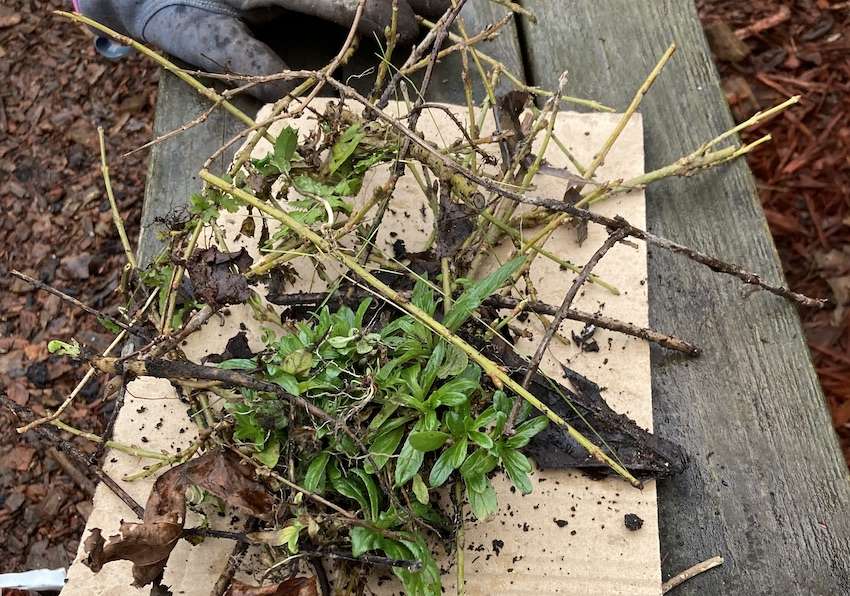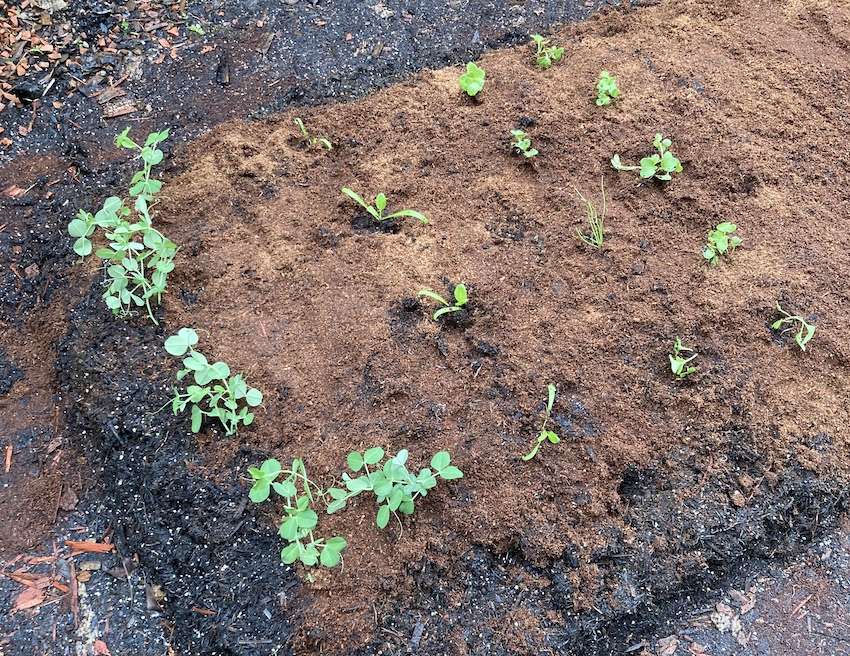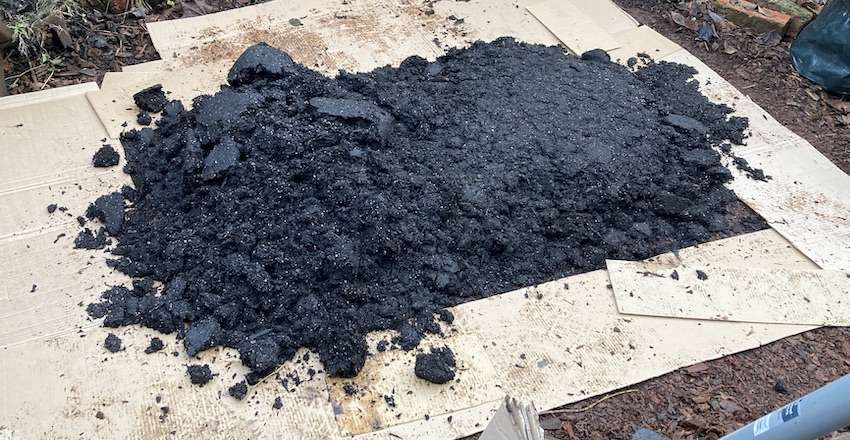When you want to start growing vegetables in the garden, and you only have a small space, you need to know where to start. This guide about how to start a small vegetable garden is especially for those who have limited space. It’s also great for those who are new to vegetable growing. I hope this article helps to cut down on the overwhelm a beginner gardener can experience. (I know I did!)
This post may contain compensated links. Read my disclaimer here.
For my own starter vegetable garden, I’ve used a combination of No Dig methods and container growing. If you’re starting a vegetable garden from scratch yourself, read on to find out how.
Contents
How to Start a Small Vegetable Garden
4 Quick Tips to Make Vegetable Gardening for Beginners Easy
1. Keep it Simple
Creating a vegetable garden is a great way to provide food for yourself and your family. But a lot of information out there can make it feel more complicated than it needs to be. This can make starting a vegetable patch seem daunting for beginners, but it doesn’t have to be.
When you keep it simple you can get growing without the stress. For example, you don’t need to get your soil tested or worry about adjusting its PH balance. You also don’t need to worry about crop rotation. Rotation may be important for some farming methods, but it isn’t needed at all in small spaces.
2. Use No Dig Methods
Using No Dig is a great way to create a vegetable garden, it’s simple and easy and there are a lot of benefits. You don’t have to spend time digging to prepare the soil. Instead of digging compost into the soil, you add a layer of compost once a year to provide nutrients.
No Dig also cuts down on the hard work of weeding. If there are weeds in your growing area you can put a mulching material like cardboard down to stop weed growth. You can then put compost on top.
This method works really well for small gardens and backyards. It leads to good-quality soil so you can make the most of the growing potential of your garden space. I learnt about No Dig from resources put together by experienced No Diggers. I recommend checking out their books and courses.*
3. Start Small
It can feel like a disadvantage to have a small space. But when you are a beginner, wondering how to grow a vegetable garden, starting small is actually a great way to go. When you start small you can focus on improving your skills while you learn.
Work with a small area and on a few key crops to get the hang of it. This way you won’t get overwhelmed with lots of different jobs in your garden. You could start with one simple vegetable bed and get used to growing vegetables with that.
I started by creating one No Dig bed that measured 1.5 by 1.2 metres. I had a bit more space to grow crops around it. But I stuck with growing on the bed at first. I knew I could expand and make use of the extra space later.

4. Use Containers to Make the Most of Your Space
If you don’t have room for a vegetable bed, or if you have some extra space to the sides, grow vegetables in containers. You can use pots and planters that fit into the smallest and most awkward spaces so you can make the most of them. This also works well for patios, porches backyards, balconies or even window ledges.
First steps – Growing Vegetables for Beginners
How to Make a Vegetable Garden
What are the Best Vegetables for a Small Garden?
If you have limited space make sure you are growing vegetables that you and your family love. You won’t want to use your small space to grow food that gets left uneaten!
I started by making a list of the vegetables that we currently use a lot of in our home. I then considered how much space different crops take up. We love vegetables like cauliflower, broccoli and squash. But I soon realised that these would take up a large proportion of my growing space.

Some of the best food to grow in small spaces are quick-to-crop veggies like radishes and peas for shoots. Lettuce, spinach and other leafy green veg are also great. Instead of one harvest, you can get an ongoing harvest from these plants. So you are really making the most of your space. Before you know it you’ll be enjoying your first harvests.
You can also grow plants that grow tall such as peas, tomatoes and broad beans. Look out for spaces in your garden where you can grow vertically by providing support for plants. You can make use of existing fencing or walls.
You will need to consider what can be grown in your region’s climate and even microclimate. While growing tall crops can save space, they may not work well if you get frequent high winds in your area. However, if your growing space is well sheltered from the wind this could be a good option.
Planning a Vegetable Garden
When you are ready to start your beginner vegetable garden it helps to have a rough plan of what you will grow. But this doesn’t have to be rigid and you don’t need to spend a long time on it. As you start growing seedlings you will start to get into a rhythm of having plants ready to fill spaces.
First, think about what vegetables you would like to grow and how they will work in your space. I think about my vegetable bed as having a number of rows and make a note of which plants I would like to add to them first.
I then consider what I could follow that with once I have harvested the first crop. For example, you can follow carrots with beetroot. Many plants grow well together so you can also use companion planting to save space.
I write a list to plan what to grow. You could also make a sketch of your growing space to make a visual plan.
This is an example of my rough planning:
Bed:
- Rows 1 and 2: Peas for shoots > follow with Potatoes
- Rows 3 and 4: Spinach > follow with Spring Onions
- Rows 5 and 6: Radish > follow with lettuce
- Rows 7 and 8: Carrots > follow with Beetroot
Containers and grow bags:
- Potatoes
- Leeks
- Basil
- Strawberries
- Cherry Tomatoes
- Thyme
- Mint
- More crops that I haven’t had room for in beds eg radish, lettuce etc
This is a very rough plan and you can expect your planning to change as you get growing. When making my initial bed plans I expected to grow a lot more different vegetables in my one bed. But as I started to transplant my seedlings I found I was running out of space. I realised I would need to adjust my expectations!
What you decide to grow will depend on what you need. How you arrange your vegetable bed may also depend on what seedlings you have ready. Take into consideration timing, your climate and the space you have.
What you start growing first in your garden will also depend on what time of the year you get started.
When to Start a Vegetable Garden
You can set up vegetable beds at any time. But if you are starting during the depths of winter you won’t be able to start planting in them. But winter is still a great time to set up and prepare your vegetable beds. You can also spend time tidying your garden, making space to grow and dealing with weeds.

I built my bed in January and then waited till March to start planting in it.
If you are starting in spring and even up to late autumn you can sow and plant various vegetables straight away. But make sure you are planting the right vegetables for the time of year so that they can thrive.
Before you plant check for new weed growth. It’s worth running a garden hoe over the bed. This will quickly remove any tiny weed seedlings, even those you can’t see.

How to Make a Raised Vegetable Garden Bed
To make a vegetable bed first plan out where you would like your bed to go.
You can create vegetable beds on any type of soil or ground. I started mine on top of concrete paving! Ideally, you should remove concrete but if that’s not possible you may still be able to make a bed there.
If you are building a veg bed on top of concrete make sure you have some drainage. If the ground is sloping, or if there are cracks or holes in the concrete this will help drainage.
My veg patch is on top of concrete paving which is well cracked. I’ve seen rainwater drain away from it so I’m confident the bed won’t waterlog.
Once you’ve measured out your space you can lay out wooden planks to create sides and help your bed keep its shape. But if you don’t have wood this is optional. I chose not to go with wood sides for my vegetable bed.
How to Stop Weeds in Your Vegetable Garden
If you are starting on ground that has weeds place cardboard from old boxes down on your planned bed area. Extend your cardboard by about 15 cm on each side of the bed. Put a light layer of compost or woodchip on it to create a path around your bed. This helps separate it from other spaces in your garden.
The cardboard will starve the weeds of light so they will die off. Make sure your pieces of cardboard overlap and don’t leave gaps for light. Some weeds, especially perennials are persistent enough to break through cardboard. So you might need to pull them out with a trowel first.
Make your Vegetable Bed
Cover the bed area with a layer of compost. Aim for about 15cm depth. Walk on and flatten down the compost as you build layers up to make sure it is firm. Even out the surface with a rake. If you are planting straight away make sure the compost is well watered.
Because I set up my bed on concrete I went for a high bed. I built up my compost to 25cm high to ensure my veggies will have enough space to grow their roots.

How to Use Compost in Your Vegetable Garden
Use compost when setting up vegetable beds as described above. Once you have established beds add a layer of compost once a year to nourish your soil. You can do this during the winter. You can also top up compost in containers. This ensures your potted perennial plants are receiving nutrients.
Compost will be one of your main expenses when starting your vegetable patch. I started making my own compost before I created my beds. But as the home compost wasn’t ready I needed to buy six 50-litre bags of compost to fill the 1.5 x 1.2-metre bed.
It’s easy to underestimate how much compost you will need! I found a useful tool to calculate how much I would need here. To reduce compost expenses look for local compost schemes and make your own compost.
*Resources by No Dig Experts
Charles Dowding has lots of courses and information on his website. You can also get his latest No Dig book here.
Stephanie Hafferty shares tips for No Dig and homesteading here.
I hope you found my guide to starting a small vegetable garden useful. I’ll be posting more about the different stages of developing your small space garden soon here on SmallSpaceGrowing.com.
Look out for posts on making your own compost in a small space, what to grow, what tools you’ll need and more.
Disclaimer: As an Amazon Associate I earn from qualifying purchases.
